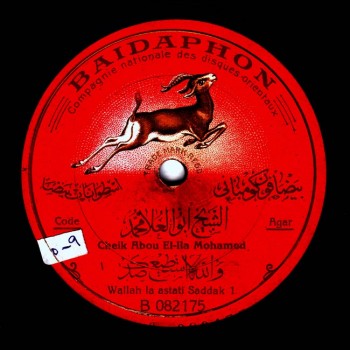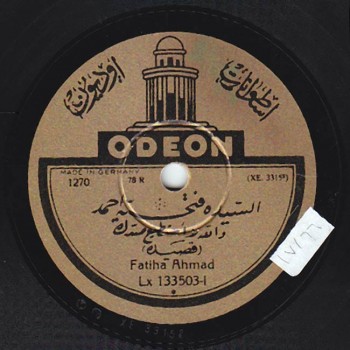The Arab Music Archiving and Research foundation (AMAR), in collaboration with the Sharjah Art Foundation (SAF), presents “Sama‘ ”.
“Sama‘ ” discusses our musical heritage through comparison and analysis.
A concept by Mustafa Said.
Dear listeners,
Welcome to a new episode of “Sama‘ ”.
This is this season’s last episode of AMAR’s show, after four consecutive years.
Today, we will resume our discussion about qaṣīda “W-al-Lāhi lā astaṭī‘u ṣaddak wa-lā urīdu al-ḥayāta ba‘dak” written by Sheikh ‘Abd al-Lāh al-Shabrāwī.
We have two recordings:
-
The recording of Abū ‘Ilā Muḥammad who is the first one who sang it.
-
An imitation of Abū ‘Ilā Muḥammad’s recording by Sitt Fatḥiyya Aḥmad, made six or seven years later.
We have discussed this in detail in our previous episode.
The second verse:
“Yā qātilī hal fa‘altu dhanban Yūjibu hādhā al-ṣudūda ‘indak”
We will mostly listen to Sheikh Abū ‘Ilā Muḥammad’s version first, followed by Sitt Fatḥiyya Aḥmad’s.
So let us now listen to Sheikh Abū al-‘Ilā Muḥammad …
(♩)
Beautiful Sheikh Abū al-‘Ilā!
He sang the second verse twice, saying “Yā qātil” instead of “Yā qātilī” the second time. I do not know if he had memorized the qaṣīda or if he was reading it.
Also, I do not know why he said the first time:
Yā qātilī hal fa‘altu dhanban Yūjibu hādhā al-ṣudūda ‘indak
And, the second time:
Yā qātil hal fa‘altu dhanbun Yūjibu hādhā al-ṣudūda ‘indak
He must have been reading the qaṣīda as he had not memorised it… or had only memorised it partly so he kept the text in front of him.
Sitt Fatḥiyya Aḥmad had memorised the qaṣīda and the melody perfectly.
Let us listen to her singing “Yā qātilī hal fa‘altu dhanban / Yūjibu hādhā al-ṣudūda ‘indak” the second time …
(♩)
Sheikh Abū al-‘Ilā Muḥammad sang it to the ṣabā busalīk …
(♩)
There is a beautiful bashraf to this tune recorded by Amīn al-Buzarī.
Sitt Fatḥiyya Aḥmad sang it twice, just like Sheikh Abū al-‘Ilā Muḥammad.
Let us listen and focus on “Yā qātil”, the second time, instead of “Yā qātilī”, just like Sheikh Abū al-‘Ilā.
Let us now listen to the first time …
(♩)
Note the long “ī”.
We must listen to it because it is Sitt Fatḥiyya Aḥmad’s first personal initiative, or added variation to Sheikh Abū al-‘Ilā Muḥammad’s version ….
(♩)
Beautiful!
This is the initiative we mentioned: she extended the phrase.
Let us listen to “Yā qātil” again …
(♩)
Beautiful Sitt Fatḥiyya!
She seems to be saying “Have mercy, criminal!”
A beautiful variation to Sheikh Abū al-‘Ilā’s recorded version.
The record of Sitt Fatḥiyya is a repetition/imitation of what Sheikh Abū al-‘Ilā sang, yet there is a difference between them –the same as in many other examples we talked about previously–: indeed, the printing of the record to the extent that even the translation/interpretation is not the same as Abū al-‘Ilā Muḥammad’s, but rather as if she were performing relaying to the muṭrib or the muṭriba a new verse or the next modulation. Which does not happen with Sitt Fatḥiyya who is expected to perform something new.
We have analysed some examples, including “Arāka ‘aṣiyy al-dam‘i” and “Wa-ḥaqqika ant al-munā w-al-ṭalab”, where the translation/interpretation precedes the original –and they are mostly by Sheikh Abū al-‘Ilā.
Let us now listen to the interpretation of the same verse …
(♩)
We have heard voices saying “Al-Lāh Sheikh Abū al-‘Ilā!” at the beginning and “Al-Lāh Quḍḍābī!” –the takht that included al-Quḍḍābī and Sāmī al-Shawwā, is the same takht that played six years later–. But there was no taṭyīb (praising) anymore as it was now considered by critics as a sign of being retrograde. Now people said “Bravo” instead of “Al-Lāh”, and attended concerts instead of “evenings” or “ḥafla-s”.
So discs did not include this mark anymore!!!…
Listeners should not change their habits because other listeners in another part of the world have different ones. To each his own…
We will talk about this some other time.
(♩)
Sitt Fatḥiyya does something that is not appreciated on the language level: in “Yūjibu hādhā al-ṣudū…da ‘indak” she takes a breath in the middle of the word …
(♩)
Cutting a word with a breath is not appreciated in qaṣīda-s.
Still, Sitt Fatḥiyya Aḥmad remains much better, in Arabic, than other muṭriba-s whose language skills were said to be great by critics. She was indeed much better, in Arabic, than most of her contemporaries, despite the linguistic mistakes we have mentioned, knowing that there are many others still.
Now, let us analyse the third and the fourth verses:
Bi-al-Lāhi bi-al-Lāhi yā ḥabībī Wa‘adta bi-al-waṣli waffi wa‘dak
Fa-lī fu’ādun yadhūbu shawqan Ilayka mahmā dhakartu bu‘dak
Let us listen to Abū al-‘Ilā Muḥammad’s version …
(♩)
There is a gradual ascension in the maqām: starting from the ḥijāz aspect in the first verse –or Turkish jahārkāh if we stop at its qarār– that he affirms, then reaches the ṣabā jawāb –not the incomplete jawāb or the continuation of the ḥijāz aspect– or the muḥayyar if the ṣabā starts at the dūkāh, then concludes to the ṣabā’s fundamental position.
Let us now listen to Sitt Fatḥiyya Aḥmad’s version, and focus on the second “Bi-al-Lāhi bi-al-Lāhi” and the ornaments that are closer to the ṣahla and that characterise women’s singing …
(♩)
“Al-Lāh” Sitt Fatḥiyya, beautiful!
Let us now listen to “Bu‘dak” by Abū al-‘Ilā Muḥammad and then by Sitt Fatḥiyya …
(♩)
Extending the “dā” is the language issue we were talking about.
The fifth verse:
“Jarra‘tanī al-hajra wa-huwa murrun Wa-ṭālamā qad rashaftu shahdak”
This verse is beautiful!
Sheikh Abū al-‘Ilā modulates to the jahārkāh from the sixth, that some name ‘ajam ‘ushayrān, which is better illustrated in Sitt Fatḥiyya Aḥmad’s version.
Let us listen to the temperaments in both Sheikh Abū al-‘Ilā’s and Sitt Fatḥiyya Aḥmad’s performances …
(♩)
The first remark that comes to the mind of the listeners is that Sitt Fatḥiyya sings the first hemistich “Jarra‘tanī al-hajra wa-huwa murrun” twice.
Let us listen to Sheikh Abū al-‘Ilā’s unique “Jarra‘tanī al-hajra wa-huwa murrun” …
(♩)
Let us listen to the first one by Sitt Fatḥiyya …
(♩)
Almost an Arpège… which indicates that al-Qaṣṣabgī’s style had started to spread. He either taught it to her, or it was an initiative on her part.
This point is confirmed in “Wa-ṭālamā qad rashaftu shahdak” that she sings following the pattern of an ascending Turkish phrase …
(♩)
This influence does not exist in the jahārkāh aspect. Thus I can say that Sheikh Abū al-‘Ilā Muḥammad sang a jahārkāh aspect from the maqām’s sixth, whereas she sang it to the Turkish Military fanfare’s ‘ajam ‘ushayrān, often found in the mihtār, and to which bashraf-s and samā‘ī-s were composed. It is a re-invented maqām from the 18th century or maybe the 19th.
The ‘ajam ‘ushayrān is the major –not the piano’s equal temperaments– that will appear in the 1960s, or even before, with the accordion, the electric guitar, and the piano. Before Sheikh Abū al-‘Ilā Muḥammad’s discs, they had started recording with an orchestra including piano and flute that played equal temperaments while the singer did not.
Anyway, we said that Sitt Fatḥiyya sang it to the ‘ajam ‘ushayrān, and that Sheikh Abū al-‘Ilā Muḥammad did not, but rather sang it to the Arabic jahārkāh temperaments –not Turkish jahārkāh temperaments that we have discussed earlier.
The following verse is the sixth verse:
“Man munṣifī minka yā malīkan”
Let us listen to the version of Abū al-‘Ilā who modulates to the ‘ushshāq …
(♩)
Instead of the jahārkāh, he modulated to the ‘ushshāq from the maqām’s fourth, so the ṣabā’s incomplete fourth does not exist anymore.
Then they translated for him, after which he concluded the side with the seventh verse: “Wa-laysa lī fī al-milāḥi” to the ṣabā.
Let us talk about the technique of Sitt Fatḥiyya Aḥmad, knowing that by that time, they had become acquainted with recording and were not hindered by a record’s duration. Cylinder recordings came after that and thus their hard work and training had become vain as a recording’s duration was not limited anymore.
The point is that when Sitt Fatḥiyya felt that the record was reaching its end, she concluded after modulating to the ‘ushshāq at the seventh verse “Wa-laysa lī” without any significant instrumental translation of the sixth verse.
Let us listen carefully to “Man munṣifī” interpreted by Sitt Fatḥiyya, and hear her beautiful ṣahla-s as well as and “jundak” at the “n” …
(♩)
Beautiful Sitt Fatḥiyya!
Both Sheikh Abū al-‘Ilā and Sitt Fatḥiyya concluded the first side with the seventh verse.
Before analysing the second side, let us listen to “wa-lākin mā aladdak” interpreted by both:
-
Sheikh Abū al-‘Ilā sang it in an ordinary manner
-
whereas Sitt Fatḥiyya did not. She did not extend the “ma” enough for us to know that “mā” is a word and “aladdak” is another word …
She seems to be saying “ma’aladdak”.
She had surely understood and comprehended the text, but sometimes the melody did not convey this, maybe because muṭriba-s had newly started to sing qaṣīda-s and were not used to this.
Note that both Sheikhs and Afandī-s also had problems with the language, as we have mentioned in previous episodes.
Side 2:
There is a unique pre-set introduction in Sitt Fatḥiyya’s version, besides the dūlāb at the start of Side 1: they had fixed the introduction of side 2, inspired by Sheikh Abū al-‘Ilā’s introduction …
(♩)
In Sheikh Abū al-‘Ilā Muḥammad’s version, it is clearly an improvisation.
In Sitt Fatḥiyya’s version, they fixed what they had improvised with Sheikh Abū al-‘Ilā …
(♩)
At the beginning of side 2, Abū al-‘Ilā’s version is unquestionably a maqsūm …
(♩)
To those who analyse qaṣīda ‘ala l-waḥda, we say –as I have said in many conferences– that the issue of the waḥda rubā‘iyya changes from one baḥr to the other. Consequently, in such a simple and cheerful baḥr, i.e. mukhalla‘ basīṭ “mustaf‘ilun fā‘ilun fa‘ūlu”, the rhythm must be lively. The middle and the major waḥda are thus not to be considered. So they used the maqsūm because it is faster and livelier. So the baḥr determines the waḥda to which the qaṣīda will be interpreted.
The waḥda rubā‘iyya can be a maqsūm.
This point is to be added to the subject of the qaṣīda ‘ala l-waḥda.
The eighth verse:
“Shārakanī fīka kullu ṣabbin” or “Shāraktanī fīka kulla ṣabbin”
Sheikh Abū al-‘Ilā sang it in an ordinary manner, i.e.:
“Shārakanī fīka kullu ṣabbin Lammā ḥawayt al-jamāla wahdak
Wa-qad ashā‘ al-‘adhūlu annī Mushabbihun bi-al-ghuṣūni qaddak”
Sitt Fatḥiyya Aḥmad sang:
“Shārakanī fīka kulla ṣabbin”
So she must have listened to “Shāraktanī fīka kulla ṣabbin”, but then went back to “Shārakanī fīka kullu ṣabbin” and mixed them up.
This linguistic issue is unimportant, since our point here is the melody:
In the eighth and the ninth verses, Sheikh Abū al-‘Ilā Muḥammad sings to the busalīk as we have mentioned earlier.
We can hear Sāmī al-Shawwā’s taṭyīb to Sheikh Abū al-‘Ilā when he reached “Lammā ḥawayt al-jamāla wahdak”, saying “Yā sīdī waḥdak” …
(♩)
Then Sheikh Abū al-‘Ilā continues to the busalīk in an ordinary manner …
(♩)
The tenth verse:
“Wa-anta ‘indī ajallu min an Yushbiha wardu al-riyāḍi khaddak”
Sitt Fatḥiyya did not sing it like Sheikh Abū al-‘Ilā. Listen to “An yushbiha” by Abu al-‘īlā …
(♩)
Sitt Fatḥiyya performed a ghunna (ditty) …
(♩)
If she had taken a breath between “yush” and “biha”, it would have been beautiful.
In this verse, the hijāz aspect is at its peak. Furthermore, the maqām’s jawāb is incomplete “Yushbiha wardu al-riyāḍi khaddak” …
(♩)
The eleventh and the twelfth verses:
“Wa-lastu yā badru artaḍī” and “Wa-yā ḥasbuk al-Lāh” are linked.
The first verse ends to the sikāh’s second, followed by the second verse:
“Yā hasbuk al-‘Lāh yā ghazālan Ghazawta bi-al-muqlatayni usdak”
Let us listen to “Yā ḥasbuk al-Lāh” by Sheikh Abū al-‘Ilā …
(♩)
It is a kawasht according to Ṣafyiddīn al-Urmawī’s categorisation. Until today, Sheikhs call this type of ṣabā “kawasht”.
Now “Yā ghazālan”. Note that the kawasht requires a heightened fourth, not only to descend from the maqām (♩).
It is a ṣabā busalīk that became a kawasht because he heightened the fourth. Note the pressure in “yā ghazālan / Ghazawta bi-al-muqlatayni usdak”
(♩)
Beautiful Sheikh Abū al-‘Ilā!
Let us now go to the following verse:
“Wa-anta yā ‘ādhilī taraffaq Fa-qad ta‘addayta fiyya ḥaddak”
In the beginning, the maqām’s fourth is still ascending, as if Sheikh Abū al-‘Ilā were still singing to the kawasht. But after this, he modulated to a ḥijāz type, he sang to the ‘ushshāq’s sixth …
(♩)
Sitt Fatḥiyya sang it as if to the ‘ajam ‘ushayrān to the maqām’s sixth …
(♩)
The following verse:
“Ta’muru bi-al-rushdi mustahāman Ya‘uddu ‘ayn al-ḍalāli rushdak”
Sheikh Abū al-‘Ilā sang it to the jahārkāh …
(♩)
Sitt Fatḥiyya Aḥmad sang it to the ‘ajam ‘ushayrān …
(♩)
And she took this performance scale “ ‘Ayn al-ḍalāl” …
(♩)
The fifteenth verse:
“Kun kayfamā shi’ta yā ḥabībī La kāna man ‘an hawāka raddak”
Let us listen to “La kāna man ‘an hawāka” by Sheikh Abū al-‘Ilā. He started it to the bayyātī then modulated to the ṣabā through lowering the fourth gradually from the bayyātī …
(♩)
Now, let us listen three times to “Kun kayfamā shi’ta yā ḥabībī”.
Sitt Fatḥiyya repeated it three times to the ‘ushshāq in an ordinary manner, the same as Abū al-‘Ilā …
(♩)
We heard the full recording in our previous episode.
Let us listen to the three times and notice how she went back to “Lā kāna man ‘an hawāka”. She went back to the ṣabā directly, without going through the bayyātī like Sheikh Abū al-‘Ilā. She did not lower the fourth gradually like Sheikh Abū al-‘Ilā when singing “Lā kāna man ‘an hawāka raddak” …
(♩)
Beautiful!
As we heard, she repeated “Kun kayfamā shi’ta yā ḥabībī” three times, each more beautiful that the last, and each time she ascended, performed jawāb, and sang clear and brilliant notes.
Beautiful Sitt Fatḥiyya!
Let us listen to the last verse in the voice of Sheikh Abū al-‘ilā who sang “Wa-hjur idhā shi’t” twice to the ṣabā’s first jins. Then he concluded, they translated for him, and he sang marvellous layālī to the ṣabā, accompanied by the qānūn and the violin.
Let us listen to Sheikh Abū al-‘Ilā’s qafla …
(♩)
Sitt Fatḥiyya did not do the same because recording did not require them to remove what critics had started to consider as defaults, such as the layālī they used to end records with, and that they also certainly sang in ḥafla-s, as they certainly were not created for the sole purposed of filling space in the records.
As we heard Sitt Fatḥiyya’s full recording last time, let us now listen to the full recording of Sheikh Abū al-‘Ilā. Note the beautiful faithful –not memorised– translation by ‘Abd al-‘Ḥamīd al-Quḍḍābī and Sāmī al-Shawwā, even though they were supposed to imitate the recording of Sheikh Abū al-‘Ilā.
They knew that Sitt Fatḥiyya had taken the initiative to vary, and did not know when she would improvise, so they had to translate without relying on their memory.
Sitt Fatḥiyya is accompanied by Sāmī al-Shawwā, ‘Abd al-Ḥamīd al-Quḍḍābī, and a percussionist who we think might be Maḥmūd Raḥmī. The recording was made by Odeon in 1927 …
(♩)
“Al-Lāh” Sitt Fatḥiyya!
Dear listeners,
We have reached the end of today’s episode of “Sama‘ ” as well as the end of this season of AMAR’s weekly podcasts during which:
-
we offered information, detailing each piece of information for them to be a reference for students as well as for our listeners
-
we hosted a number of great musicians and music researchers
Every time we presented a personal conclusion, we mentioned it was personal and never claimed it was confirmed information.
Every time we presented confirmed information, we documented it, and even travelled just to obtain information to offer listeners and students.
There were certainly mistakes… Great scientists, whatever their field of study, were confronted to mistakes… which is natural and human. Still, we apologise for any mistake in any of our episodes throughout these four years.
We will meet again in a new episode in our next season of AMAR’s show.
“Sama‘ ” was presented to you by AMAR.
- 221 – Zakariyya Ahmed – 12 (1/9/2022)
- 220 – Zakariyya Ahmed – 11 (1/9/2022)
- 219 – Zakariyya Ahmed – 10 (11/25/2021)
- 218 – Zakariyya Ahmed – 9 (10/26/2021)
- 217 – Zakariyya Ahmed – 8 (9/24/2021)
- 216 – Zakariyya Ahmed – 7 (9/4/2021)
- 215 – Zakariyya Ahmed – 6 (8/28/2021)
- 214 – Zakariyya Ahmed – 5 (8/6/2021)
- 213 – Zakariyya Ahmed – 4 (6/26/2021)
- 212 – Zakariyya Ahmed – 3 (5/27/2021)
- 211 – Zakariyya Ahmed – 2 (5/1/2021)
- 210 – Zakariyya Ahmed – 1 (4/28/2021)
- 209 – W-al-Lāhi lā astaṭī‘u ṣaddak 2 (4/6/2017)
- 208 – W-al-Lāhi lā astaṭī‘u ṣaddak 1 (3/30/2017)
- 207 – Bashraf qarah baṭāq 7 (3/23/2017)




